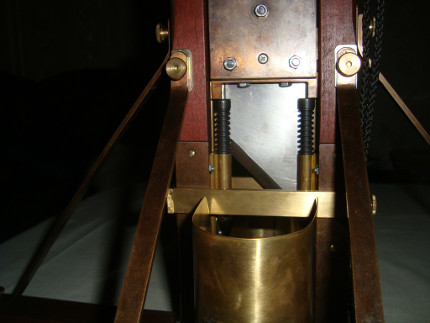At one time, specifically during the French Revolution, the guillotine was the iPad of instruments of death. It was a clean, efficient, humane method of decapitation. Though no killing machine could replace the personal touch of a live executioner with an axe to grind, the executioner might not always get your head off on the first try. Whether a convicted criminal, a Saint, or both, the guillotine was preferable to crucifixion, stoning, hanging, and burning at the stake.
Today, lethal injection is the more gentle, modern-day guillotine. With a push of a button, poison enters the veins, and the convict drifts away into an eternal, dreamless sleep. Humane or not, this clean, sterile death seems well-suited to the sentiments of high society.
***
On March, 18 2013 Dr. Kermit Gosnell went on trial in Philadelphia for eight counts of murder – seven babies and one adult. If you’re surprised that you haven’t heard about Dr. Gosnell’s trial before now, you’re not alone; until recently it hadn’t made headlines among the mainstream media.
Here are the details: Gosnell, a West Philadelphia abortion doctor has performed hundreds of abortions in his career. According to Philadelphia Grand Jury reports his clinic “reeked of animal urine, courtesy of the cats that were allowed to roam (and defecate) freely. Furniture and blankets were stained with blood. Instruments were not properly sterilized. Disposable medical supplies were not disposed of; they were reused, over and over again.”
The details of the conditions of Gosnell’s “House of Horrors”, as it’s been called, are nauseating. The lack of sanitation caused infections, spread venereal diseases, and endangered the lives of his patients. He trained teenagers as his assistants, teaching them to administer anesthesia and assist with abortions. He often treated low-income women in these circumstances, often violating the law by so doing. In Pennsylvania, for example, it is prohibited to abort fetuses in the third trimester. Dr. Gosnell is alleged to have aborted babies in their sixth and seventh month of development.
It is speculated that Gosnell performed hundreds of illegal abortions over the past few decades. Gory details of these abortions are not lacking. The few websites initially covering the story describe fetuses “screeching,” spinal cord snipping, and infant beheading.1
Three days ago Kirstin Powers of USA Today became one of the first mainstream reporters to cover the trial. Her article, which is similarly unsparing, ends with an unnerving statement: “You don’t have to oppose abortion rights to find late-term abortion abhorrent or to find the Gosnell trial eminently newsworthy. This is not about being “pro-choice” or “pro-life.” It’s about basic human rights.”
***
Her closing line is absolutely right, it is about basic human rights. But let’s get the basics straight. Calling him a “baby killer,” “serial killer,” “mass murderer,” “sadistic monster” is to let him, and to let us Americans, off the hook too easily. Even blaming the mainstream media for not giving us what we don’t really want is an evasion of the more cutting questions.
I wonder: what is it that’s really so disturbing about this whole ordeal? Did I, upon hearing about the gruesome details of Dr. Gosnell’s practice, feel more disturbed by what he did, or by how he did it?
Because, although Ms. Powers’s closing line is dead on, I think her preceding line is not. It’s precisely the way our guts churn as we read the facts of Dr. Gosnell’s case that forces us to confront whether we’re actually willing to support abortions or not.
And it’s the awkward question of why we’re disturbed by these details and not others that I want to raise. If Dr. Kermit Gosnell was a reputable doctor with a highly qualified staff in the most safe and sterile clinic in the nation, would a legal beheading of a fetus in the second trimester be less disturbing? Is the severing of a fetus’ spine inside the womb more tolerable than one outside? Why?
Again from the Philadelphia’s Grand Jury report: “[O]ne of the most bizarre things about this case is Dr. Gosnell’s fetal foot collection.… No civilized society can accept such an abomination, whether the fetuses in question were viable or not. Although current law prohibits abuse of corpse, there may be some question about how that law applies in the case of fetal remains.”
Is the fetal foot collection really one of the most bizarre things about this case? On the one hand, yes, we’re disgusted by the gory details. On the other, we’re still trying to preserve the distance between the terms “corpse” and “fetal remains.”
Would the abortions Gosnell performed be more professional and acceptable if there were no blood, no noise, and no pain?
***
I don’t pose these questions to use them like a hammer. Nor are they meant to have the gotcha-effect of Zen riddles. I hope that it is already evident that I have strong opinions about this case and, I think, reasons for those opinions. The point I mean to make is that the Gosnell case is a powerful symbol for our divided country precisely because it forces us to answer these questions again, just when we thought we had them settled in our minds.
The politically correct refusal to confront the uncomfortable questions that Dr. Gosnell raises about our society is the dissonant elevator music playing in the background of recent news reports. Gosnell would no doubt have caused less stirr had he learned from Dr. Joseph Ignace Guillotine and practiced a cleaner method of execution. But it’s evident that cleanliness has not forced us to confront the schizophrenia with which we live in modern America. Dr. Gosnell, ironically, has.
[Author’s note: I recognize the complexities of women’s positions on the intersection of abortion, women’s health and women’s rights. If anyone would like to comment on ways these positions might affect the points I have tried to make above, the TJP Editors and I will do our best to respond.]
— — // — —
- An example of such a graphic article can be found here. ↩




